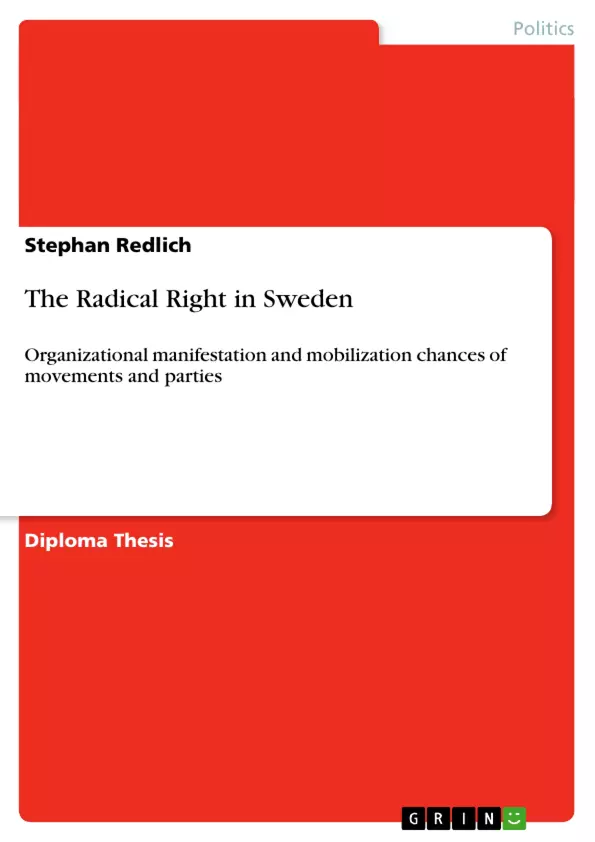The research on the Radical Right dealt marginally with Sweden in comparison to other European cases such as Germany and France. That was caused, among other things, by the fact that Sweden is still a negative case in terms of successful Right wing parties. The assumption in this particular case was negatively derived from a party research perspective. However, the
social movement research shows another picture when it comes to Radical Right phenomena below the surface of party organization. The Radical Right movements in Sweden are rather strong and in some cases tremendously well organized.
Obviously, there is a certain gap between these two perspectives. This is not caused by contradicting findings of both research traditions per se. It is rather an outcome of the specific range of each research tradition and the empirical bipolarity of the case. While the classical party research states a negative case in terms of successful parties, the research on social
movements and milieus highlights a picture of traditionally strong and vital Right wing forces below the perceptional focus of party research. A research on the whole phenomenon, including both party level dimension and movement level dimension and their interacting mobilization conditions,
has not jet been done.
It is the aim of this paper to fill this research gap by focusing on the Swedish
case and by combining both party and social movement research in order to understand and possibly explain the above-described bipolarity more deeply than it has been done separately before. In doing so I can hopefully supplement to a more complete picture on the Swedish party landscape,
especially the phenomenon of a continued absence of an established RR party while at the same time movement type organizations enjoy a relative strength.
Inhaltsverzeichnis (Table of Contents)
- 1. Introduction: Relevance of the topic and purpose of the paper.
- 1.1 The current state of research
- 1.1.1 The theory
- 1.1.2 State of research on Sweden and Scandinavia
- 1.2 Terms and definitions
- 2. The actors and their relevance in this paper
- 3. Analytical Model: Why and how the Radical Right exists?
- 3.1 Concept on RR's organizational manifestation (Minkenberg)
- 3.2 Second model: Rydgren's approach
- 3.3 The Synthesis
- 4. Analysis of the case
- 4.1 Historical tradition and political culture
- 4.2 Conflict patterns
- 4.3 Presence or absence of societal strains
- 4.4 Availability of a potent master frame
- 4.5 Agenda setting ability, politicization of new issues, elite allies, access to mass media
- 4.6 State's capacity and propensity for repression
- 4.7 Degree of convergence in political space
- 4.8 Relative openness or closure of the institutionalized political system
Zielsetzung und Themenschwerpunkte (Objectives and Key Themes)
This paper aims to bridge the gap between party research and social movement research regarding the Radical Right in Sweden. It analyzes the reasons behind the seemingly contradictory observations: a lack of successful Radical Right parties despite the presence of strong, well-organized movements. The study combines both research perspectives to provide a more complete understanding of the Swedish political landscape, focusing specifically on the continued absence of an established Radical Right party alongside the strength of movement-type organizations.
- The contrasting perspectives of party research and social movement research on the Radical Right in Sweden.
- The mobilization potential for the Radical Right in Sweden within its political and social context.
- The historical context and political culture of Sweden's relationship with the Radical Right.
- Analysis of the factors contributing to the success or failure of Radical Right parties and movements in Sweden.
- The role of political opportunity structures and mobilization potential in shaping the Radical Right landscape in Sweden.
Zusammenfassung der Kapitel (Chapter Summaries)
Chapter 1: Introduction introduces the research gap concerning the study of the Radical Right in Sweden, highlighting the discrepancy between party and social movement research perspectives. It outlines the paper's objective to combine these perspectives for a more comprehensive analysis.
Chapter 2: The Actors will likely delve into a description of the key actors and organizations involved in the Swedish Radical Right scene, laying the groundwork for the subsequent analysis.
Chapter 3: Analytical Model presents the theoretical framework used to analyze the presence and nature of the Radical Right in Sweden, likely drawing upon existing models and adapting them to the Swedish context.
Chapter 4: Analysis of the Case will apply the analytical model to the Swedish case study, examining historical traditions, conflict patterns, societal strains, and the role of media and political opportunities in shaping the Radical Right's development.
Schlüsselwörter (Keywords)
Radical Right, Sweden, social movements, political parties, political opportunity structures, mobilization, historical context, political culture, party research, social movement research, electoral success, Scandinavia.
- Quote paper
- Stephan Redlich (Author), 2007, The Radical Right in Sweden, Munich, GRIN Verlag, https://www.grin.com/document/122858



